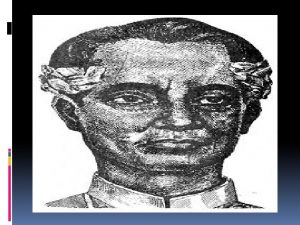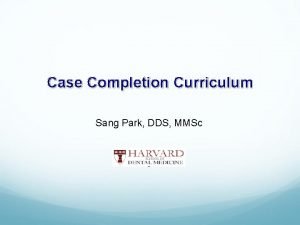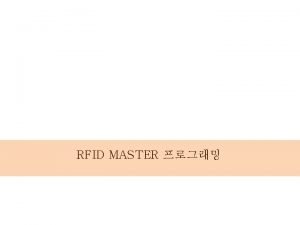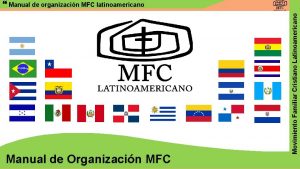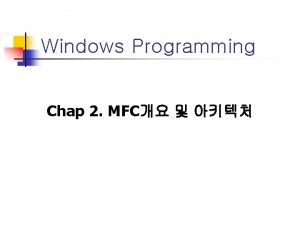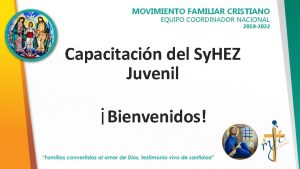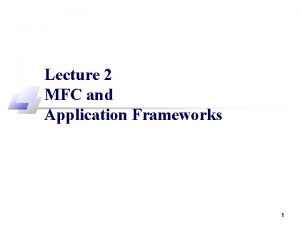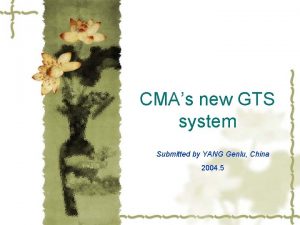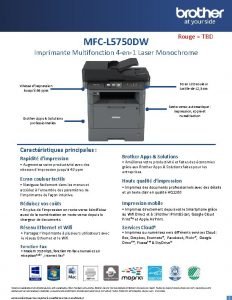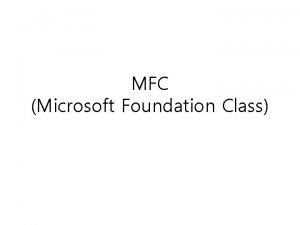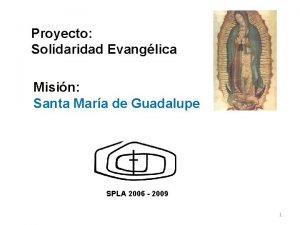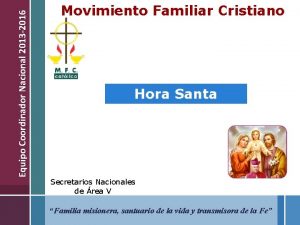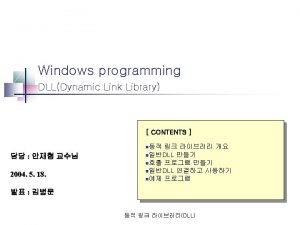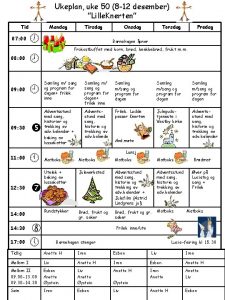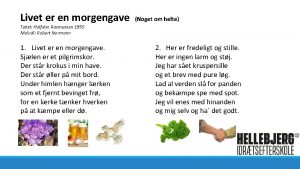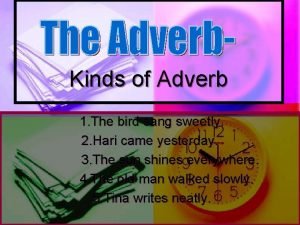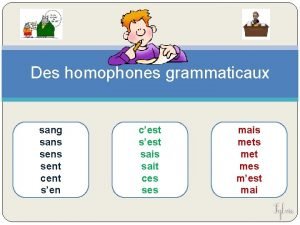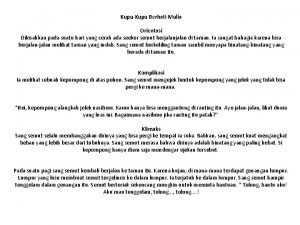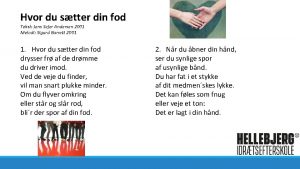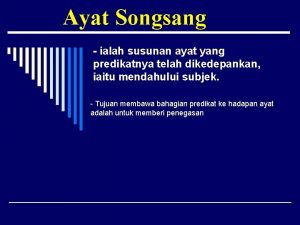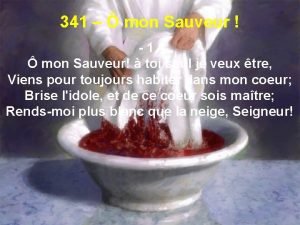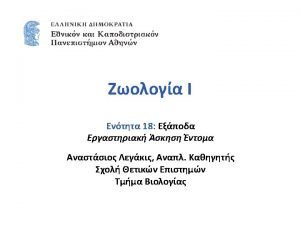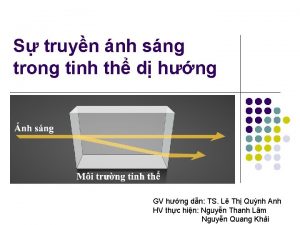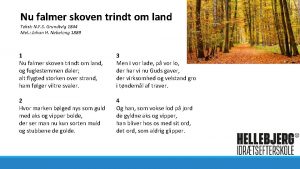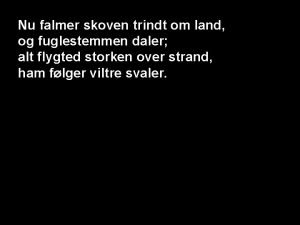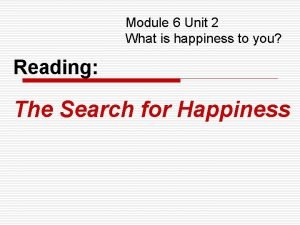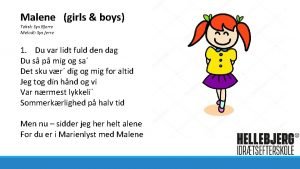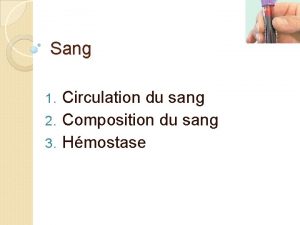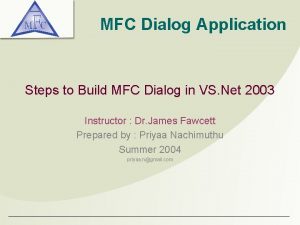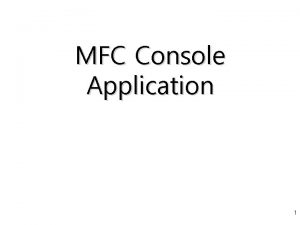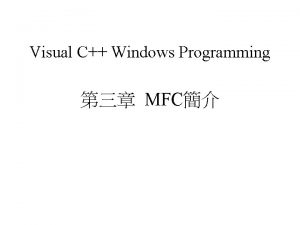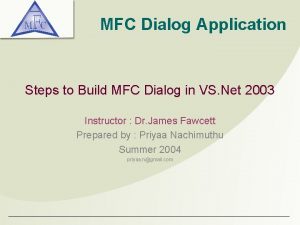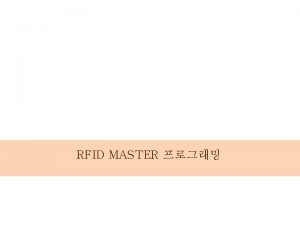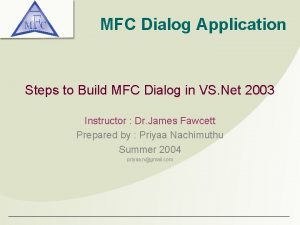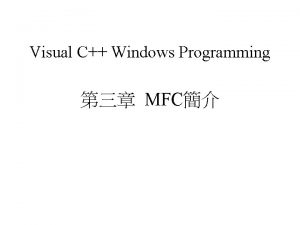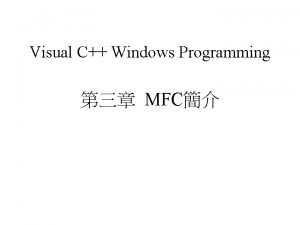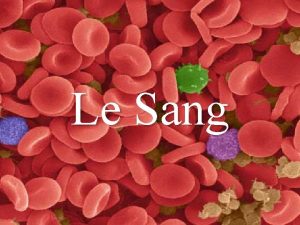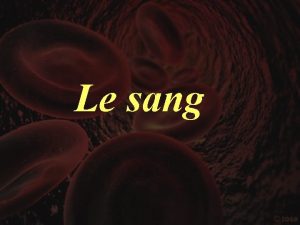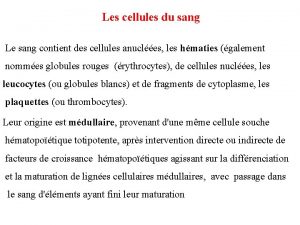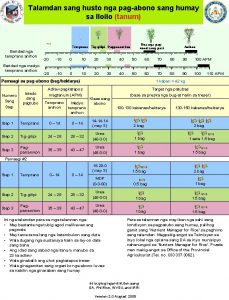MFC Department of Digital Contents Sang Il Park



























![구조체의 정의 • Example) struct student { char name[30]; int number; float grade; }; 구조체의 정의 • Example) struct student { char name[30]; int number; float grade; };](https://slidetodoc.com/presentation_image_h2/3586d3ec41d0a54d92ab793a30bd27ec/image-28.jpg)
![구조체 타입의 변수 선언 구조체이름 구조체변수이름; struct student { char name[30]; int number; float 구조체 타입의 변수 선언 구조체이름 구조체변수이름; struct student { char name[30]; int number; float](https://slidetodoc.com/presentation_image_h2/3586d3ec41d0a54d92ab793a30bd27ec/image-29.jpg)
















































- Slides: 77

MFC 시작하기 Department of Digital Contents Sang Il Park


간단한 메시지 기반 프로그래밍의 예 #include <iostream> using namespace std; int main() { int i; while(true) { cout<<"Input: "; cin>>i; Message Loop Message Handler } switch(i) { case 1: cout<<"Sejong University"<<endl; break; case 2: cout<<"Digital Contents"<<endl; break; case 3: cout<<"Bye!"<<endl; return 0; break; default: break; } } return 0;

좀 더 멋있게… void procedure(int msg) { switch(msg) { case 1: cout<<"Sejong University"<<endl; break; case 2: cout<<"Digital Contents"<<endl; break; case 3: int main() cout<<"Bye!"<<endl; { exit(0); int i; break; default: while(true) break; { } cout<<"Input: "; } cin>>i; procedure(i); } return 0; }


A Simple win 32 code // // FUNCTION: Wnd. Proc(HWND, UINT, WPARAM, LPARAM) // // PURPOSE: Processes messages for the main window. // // // WM_COMMAND - process the application menu // FUNCTION: My. Register. Class() // WM_PAINT - Paint the main window // // WM_DESTROY - post a quit message and return // PURPOSE: Registers the window class. // // COMMENTS: LRESULT CALLBACK Wnd. Proc(HWND h. Wnd, UINT message, WPARAM w. Param, LPARAM // l. Param) // This function and its usage are only necessary if you {want this code // test. Win 32. cpp : Defines the entry point for the application. // to be compatible with Win 32 systems prior to the 'Register. Class. Ex' int wm. Id, wm. Event; // // function that was added to Windows 95. It is important to call this PAINTSTRUCT ps; function HDC hdc; #include "stdafx. h" // so that the application will get 'well formed' small icons associated #include "test. Win 32. h" // with it. switch (message) // { #define MAX_LOADSTRING 100 ATOM My. Register. Class(HINSTANCE h. Instance) case WM_COMMAND: { wm. Id = LOWORD(w. Param); // Global Variables: WNDCLASSEX wcex; wm. Event = HIWORD(w. Param); HINSTANCE h. Inst; // Parse the menu selections: wcex. cb. Size = sizeof(WNDCLASSEX); switch (wm. Id) // current instance { TCHAR sz. Title[MAX_LOADSTRING]; wcex. style case IDM_ABOUT: // The title bar = CS_HREDRAW | CS_VREDRAW; // Message. Box(h. Wnd, text wcex. lpfn. Wnd. Proc = Wnd. Proc; _T("haha"), _T("about"), MB_OK); TCHAR sz. Window. Class[MAX_LOADSTRING]; wcex. cb. Cls. Extra = 0; Dialog. Box(h. Inst, // the main window class name wcex. cb. Wnd. Extra = 0; MAKEINTRESOURCE(IDD_ABOUTBOX), h. Wnd, About); wcex. h. Instance = h. Instance; break; // Forward declarations of functions included in this code module: wcex. h. Icon case IDM_EXIT: ATOM = Load. Icon(h. Instance, MAKEINTRESOURCE(IDI_TESTWIN 32)); My. Register. Class(HINSTANCE h. Instance); wcex. h. Cursor = Destroy. Window(h. Wnd); BOOL Load. Cursor(NULL, IDC_ARROW); break; Init. Instance(HINSTANCE, int); wcex. hbr. Background = (HBRUSH)(COLOR_WINDOW+1); default: LRESULT CALLBACK Wnd. Proc(HWND, UINT, WPARAM, LPARAM); wcex. lpsz. Menu. Name = MAKEINTRESOURCE(IDC_TESTWIN 32); return INT_PTR CALLBACK About(HWND, UINT, WPARAM, LPARAM); wcex. lpsz. Class. Name = sz. Window. Class; Def. Window. Proc(h. Wnd, message, w. Param, l. Param); wcex. h. Icon. Sm = } int APIENTRY _t. Win. Main(HINSTANCE h. Instance, Load. Icon(wcex. h. Instance, MAKEINTRESOURCE(IDI_SMALL)); break; HINSTANCE h. Prev. Instance, case WM_PAINT: LPTSTR lp. Cmd. Line, return Register. Class. Ex(&wcex); hdc = Begin. Paint(h. Wnd, &ps); int n. Cmd. Show) } // TODO: Add any drawing code here. . . { RECT rect; UNREFERENCED_PARAMETER(h. Prev. Instance); // Get. Client. Rect(h. Wnd, &rect); UNREFERENCED_PARAMETER(lp. Cmd. Line); // FUNCTION: Init. Instance(HINSTANCE, int) Draw. Text(hdc, _T("hello, Windows"), // 1, &rect, DT_SINGLELINE|DT_CENTER|DT_VCENTER); // TODO: Place code here. // PURPOSE: Saves instance handle and creates main window End. Paint(h. Wnd, &ps); MSG msg; // break; HACCEL h. Accel. Table; // COMMENTS: case WM_DESTROY: // Post. Quit. Message(0); // Initialize global strings // In this function, we save the instance handle in a global variable break; Load. String(h. Instance, IDS_APP_TITLE, andsz. Title, default: MAX_LOADSTRING); // create and display the main program window. return Def. Window. Proc(h. Wnd, message, Load. String(h. Instance, IDC_TESTWIN 32, sz. Window. Class, // w. Param, l. Param); MAX_LOADSTRING); BOOL Init. Instance(HINSTANCE h. Instance, int n. Cmd. Show) } My. Register. Class(h. Instance); { return 0; HWND h. Wnd; } // Perform application initialization: if (!Init. Instance (h. Instance, n. Cmd. Show)) h. Inst = h. Instance; // Store instance handle in our global//variable Message handler for about box. { INT_PTR CALLBACK About(HWND h. Dlg, UINT message, WPARAM w. Param, LPARAM return FALSE; h. Wnd = Create. Window(sz. Window. Class, sz. Title, WS_OVERLAPPEDWINDOW, l. Param) } CW_USEDEFAULT, 0, NULL, h. Instance, NULL); { UNREFERENCED_PARAMETER(l. Param); h. Accel. Table = Load. Accelerators(h. Instance, if (!h. Wnd) switch (message) MAKEINTRESOURCE(IDC_TESTWIN 32)); { { return FALSE; case WM_INITDIALOG: // Main message loop: } return (INT_PTR)TRUE; while (Get. Message(&msg, NULL, 0, 0)) { Show. Window(h. Wnd, n. Cmd. Show); case WM_COMMAND: if (!Translate. Accelerator(msg. hwnd, Update. Window(h. Wnd); if (LOWORD(w. Param) == IDOK || h. Accel. Table, &msg)) LOWORD(w. Param) == IDCANCEL) { return TRUE; { } End. Dialog(h. Dlg, Translate. Message(&msg); LOWORD(w. Param)); return Dispatch. Message(&msg); (INT_PTR)TRUE; } } } break; } return (int) msg. w. Param; return (INT_PTR)FALSE; } }

Code in short BOOL Init. Instance(…) { h. Wnd = Create. Window(…); int APIENTRY _t. Win. Main(…) { // Perform application initialization: if (!Init. Instance (h. Instance, n. Cmd. Show)) { return FALSE; } // Main message loop: while (Get. Message(&msg, NULL, 0, 0)) { if (!Translate. Accelerator(…)) { Translate. Message(&msg); Dispatch. Message(&msg); } } } return (int) msg. w. Param; Show. Window(h. Wnd, n. Cmd. Show); Update. Window(h. Wnd); } return TRUE; LRESULT CALLBACK Wnd. Proc(…) { switch (message) { case WM_COMMAND: break; case WM_PAINT: break; case WM_DESTROY: Post. Quit. Message(0); break; default: return; } return 0; }

Code in short BOOL Init. Instance(…) { h. Wnd = Create. Window(…); int APIENTRY _t. Win. Main(…) { // Perform application initialization: if (!Init. Instance (h. Instance, n. Cmd. Show)) { return FALSE; } // Main message loop: while (Get. Message(&msg, NULL, 0, 0)) { if (!Translate. Accelerator(…)) { Translate. Message(&msg); Dispatch. Message(&msg); } } } return (int) msg. w. Param; Show. Window(h. Wnd, n. Cmd. Show); Update. Window(h. Wnd); } return TRUE; LRESULT CALLBACK Wnd. Proc(…) { switch (message) { case WM_COMMAND: break; case WM_PAINT: break; case WM_DESTROY: Post. Quit. Message(0); break; default: return; } return 0; }


MFC ?





The simplest MFC application • • • Single Document No Document/View architecture support No database support No Active. X control No Docking toolbar No Initial status bar



Look into the codes

C++? CLASS?








![구조체의 정의 Example struct student char name30 int number float grade 구조체의 정의 • Example) struct student { char name[30]; int number; float grade; };](https://slidetodoc.com/presentation_image_h2/3586d3ec41d0a54d92ab793a30bd27ec/image-28.jpg)
구조체의 정의 • Example) struct student { char name[30]; int number; float grade; };
![구조체 타입의 변수 선언 구조체이름 구조체변수이름 struct student char name30 int number float 구조체 타입의 변수 선언 구조체이름 구조체변수이름; struct student { char name[30]; int number; float](https://slidetodoc.com/presentation_image_h2/3586d3ec41d0a54d92ab793a30bd27ec/image-29.jpg)
구조체 타입의 변수 선언 구조체이름 구조체변수이름; struct student { char name[30]; int number; float grade; }; student a, b;

멤버로의 접근 구조체변수이름. 맴버변수이름 struct score { int korean; int math; }; score a; a. korean = 30; a. math = 80;



구조체의 맴버 변수 접근 예 struct rectangle { int x, y; int width, height; }; rectangle rc; rectangle * p = &rc; rc. x=10; (*p). x = 10; p->x = 10; 모두 같다








디폴트 생성자(Default Constructors) • 디폴트 생성자의 추가 class Point { public: int x, y; void Print(); Point(); }; Point: : Point() { x = 0; y = 0; } // 실제 실행 시. . Point pt; pt. Print(); // 생성자가 호출된다.

인자가 있는 생성자 • 인자가 있는 생성자의 추가 class Point { public: int x, y; void Print(); Point(int initial. X, int initial. Y); }; Point: : Point(int initial. X, int initial. Y) { x = initial. X; y = initial. Y; } // 중간 생략 Point pt(3, 5); pt. Print();

소멸자 • 소멸자를 사용해서 할당한 메모리를 해제하는 예 class Dynamic. Array { public: int* arr; Dynamic. Array(int array. Size); ~Dynamic. Array(); }; Dynamic. Array: : Dynamic. Array(int array. Size) { // 동적으로 메모리를 할당한다. arr = new int [array. Size]; } Dynamic. Array: : ~Dynamic. Array() { // 메모리를 해제한다. delete[] arr; arr = NULL; }


접근 권한 설정하기(1) • 멤버의 접근 권한을 설정하는 예 class Access. Control { public: char public. Data; void public. Func() {}; protected: int protected. Data; void protected. Func() {}; private: float private. Data; void private. Func() {}; }; int main() { // 객체를 생성하고, 각 멤버에 접근해보자 Access. Control ac; ac. public. Data = 'A'; ac. public. Func(); ac. protected. Data = 100; ac. protected. Func(); ac. private. Data = 4. 5 f; ac. private. Func(); return 0; } // // // 성공 성공 실패 실패



Homework #1 • 클래스 상속의 연습 – My. Shape Class 정의하기 • 맴버변수: float _x, _y • 생성자: My. Shape(float x, float y) _x와 _y의 값을 설정 • 맴버함수: void Draw() const – 아래와 같은 내용 출력 [SHAPE] position = ( ‘_x값’, ‘_y값’ ) – My. Rect Class 정의하기 • • My. Shape Class로부터 상속 맴버변수: float _width, _height 생성자: My. Rect(float x, float y, float w, float h) 맴버함수: void Draw() const – 아래와 같은 내용 출력 [RECTANGLE] position = ( ‘_x값’, ‘_y값’), size = (‘_width’, ‘_height’)

Homework #1 • 클래스 상속의 연습 – My. Circle Class 정의하기 • • My. Shape Class로부터 상속 맴버변수: float _radius 생성자: My. Circle(float x, float y, float radius) 맴버함수: void Draw() const – 아래와 같은 내용 출력 [CIRCLE] position = ( ‘_x값’, ‘_y값’), radius = ‘_radius’

Homework #1 • 클래스 상속의 연습의 test - 다음과 같은 main 함수를 이용 int main() { My. Shape* shapes[5] = {NULL}; shapes[0] shapes[1] shapes[2] shapes[3] shapes[4] = = = new new new My. Circle( 100, 50); My. Rect( 300, 100, 100); My. Rect( 200, 100, 50, 150); My. Circle(100, 300, 150); My. Rect( 200, 200); for (int i = 0; i < 5; ++i) shapes[i]->Draw(); for (i = 0; i < 5; ++i) { delete shapes[i]; shapes[i] = NULL; } }




s e ass cl Look into the codes


프로그램 내부 구조 the. App (CSimple. App : CWin. App) m_p. Main. Frame (CMain. Frame : CFrame. Wnd) m_wnd. View (CChild. View : CWnd)

응용 프로그램 실행순서 CSimple. App the. App; Win. Main() { } // MFC 내부에 숨겨짐 the. App. Init. Instance(); // 초기화 the. App. Run(); // 메시지 루프 the. App. Exit. Instance(); // 종료

응용 프로그램 클래스 (1/4) // Simple. h class CSimple. App : public CWin. App { public: CSimple. App(); virtual BOOL Init. Instance(); }; afx_msg void On. App. About(); DECLARE_MESSAGE_MAP() 58

응용 프로그램 클래스 (2/4) MFC 기본 header file을 모아놓음 #include "stdafx. h" #include "simple. h" #include "Main. Frm. h“ // Simple. cpp BEGIN_MESSAGE_MAP(CSimple. App, CWin. App) ON_COMMAND(ID_APP_ABOUT, On. App. About) END_MESSAGE_MAP() CSimple. App: : CSimple. App() { } CSimple. App the. App; // 응용프로그램 자신에 해당하는 전역객체 59

응용 프로그램 클래스 (3/4) BOOL CSimple. App: : Init. Instance() { Set. Registry. Key(_T("Local App. Wizard-Generated Applications")); CMain. Frame* p. Frame = new CMain. Frame; m_p. Main. Wnd = p. Frame; p. Frame->Load. Frame(IDR_MAINFRAME, WS_OVERLAPPEDWINDOW | FWS_ADDTOTITLE, NULL); p. Frame->Show. Window(SW_SHOW); p. Frame->Update. Window(); } return TRUE; 60

응용 프로그램 클래스 (3/4) BOOL CSimple. App: : Init. Instance() { Set. Registry. Key(_T("Local App. Wizard-Generated Applications")); CMain. Frame* p. Frame = new CMain. Frame; m_p. Main. Wnd = p. Frame; p. Frame->Load. Frame(IDR_MAINFRAME, WS_OVERLAPPEDWINDOW | FWS_ADDTOTITLE, NULL); p. Frame->Show. Window(SW_SHOW); p. Frame->Update. Window(); } return TRUE; 61

응용 프로그램 실행순서 CSimple. App the. App; Win. Main() { } // MFC 내부에 숨겨짐 the. App. Init. Instance(); // 초기화 the. App. Run(); // 메시지 루프 the. App. Exit. Instance(); // 종료



프레임 윈도우 클래스 (1/5) // Main. Frm. h class CMain. Frame : public CFrame. Wnd { public: CMain. Frame(); protected: DECLARE_DYNAMIC(CMain. Frame) public: virtual BOOL Pre. Create. Window(CREATESTRUCT& cs); virtual BOOL On. Cmd. Msg(UINT n. ID, int n. Code, void* p. Extra, AFX_CMDHANDLERINFO* p. Handler. Info); virtual ~CMain. Frame(); CChild. View m_wnd. View; protected: afx_msg int On. Create(LPCREATESTRUCT lp. Create. Struct); afx_msg void On. Set. Focus(CWnd *p. Old. Wnd); DECLARE_MESSAGE_MAP() }; 65

프레임 윈도우 클래스 (2/5) // Main. Frm. cpp IMPLEMENT_DYNAMIC(CMain. Frame, CFrame. Wnd) BEGIN_MESSAGE_MAP(CMain. Frame, CFrame. Wnd) ON_WM_CREATE() ON_WM_SETFOCUS() END_MESSAGE_MAP() CMain. Frame: : CMain. Frame() { } CMain. Frame: : ~CMain. Frame() { } 66

프레임 윈도우 클래스 (3/5) int CMain. Frame: : On. Create(LPCREATESTRUCT lp. Create. Struct) { if (CFrame. Wnd: : On. Create(lp. Create. Struct) == -1) return -1; if (!m_wnd. View. Create(NULL, AFX_WS_DEFAULT_VIEW, CRect(0, 0, 0, 0), this, AFX_IDW_PANE_FIRST, NULL)) { TRACE 0("Failed to create view windown"); return -1; } } return 0; 67

프레임 윈도우 클래스 (4/5) BOOL CMain. Frame: : Pre. Create. Window(CREATESTRUCT& cs) { if( !CFrame. Wnd: : Pre. Create. Window(cs) ) return FALSE; cs. dw. Ex. Style &= ~WS_EX_CLIENTEDGE; cs. lpsz. Class = Afx. Register. Wnd. Class(0); return TRUE; } 68

프레임 윈도우 클래스 (4/5) struct CREATESTRUCT{ LPVOID lp. Create. Params; HINSTANCE h. Instance; HMENU h. Menu; HWND hwnd. Parent; int cy; int cx; int y; int x; LONG style; LPCTSTR lpsz. Name; LPCTSTR lpsz. Class; DWORD dw. Ex. Style; }; 69

프레임 윈도우 클래스 (5/5) void CMain. Frame: : On. Set. Focus(CWnd* p. Old. Wnd) { m_wnd. View. Set. Focus(); } BOOL CMain. Frame: : On. Cmd. Msg(UINT n. ID, int n. Code, void* p. Extra, AFX_CMDHANDLERINFO* p. Handler. Info) { if (m_wnd. View. On. Cmd. Msg(n. ID, n. Code, p. Extra, p. Handler. Info)) return TRUE; } return CFrame. Wnd: : On. Cmd. Msg(n. ID, n. Code, p. Extra, p. Handler. Info); 70


뷰 클래스 (1/4) // Child. View. h class CChild. View : public CWnd { public: CChild. View(); protected: virtual BOOL Pre. Create. Window(CREATESTRUCT& cs); public: virtual ~CChild. View(); protected: afx_msg void On. Paint(); DECLARE_MESSAGE_MAP() }; 72

뷰 클래스 (2/4) // Child. View. cpp CChild. View: : CChild. View() { } CChild. View: : ~CChild. View() { } BEGIN_MESSAGE_MAP(CChild. View, CWnd ) ON_WM_PAINT() END_MESSAGE_MAP() 73

뷰 클래스 (3/4) BOOL CChild. View: : Pre. Create. Window(CREATESTRUCT& cs) { if (!CWnd: : Pre. Create. Window(cs)) return FALSE; cs. dw. Ex. Style |= WS_EX_CLIENTEDGE; cs. style &= ~WS_BORDER; cs. lpsz. Class = Afx. Register. Wnd. Class ( CS_HREDRAW|CS_VREDRAW|CS_DBLCLKS, : : Load. Cursor(NULL, IDC_ARROW), HBRUSH(COLOR_WINDOW+1), NULL); } return TRUE; Style: http: //msdn 2. microsoft. com/en-us/library/ms 632600(VS. 85). aspx 74 Ex. Style: http: //msdn 2. microsoft. com/en-us/library/ms 632680(VS. 85). aspx System Color: http: //msdn 2. microsoft. com/en-us/library/ms 724371. aspx

뷰 클래스 (4/4) void CChild. View: : On. Paint() { CPaint. DC dc(this); dc. Text. Out(100, _T("안녕하세요. “)); } 75


 Mambabalagtas
Mambabalagtas Sang park dds
Sang park dds Brush mountain park orchard park
Brush mountain park orchard park Northwick park emergency department
Northwick park emergency department C++ mfc 예제
C++ mfc 예제 Estructura del mfc
Estructura del mfc Manual de identidad y ordenamientos del mfc pdf
Manual de identidad y ordenamientos del mfc pdf Mfc internals
Mfc internals Decalogo del equipo mfc
Decalogo del equipo mfc Mapstruct cannot find implementation for
Mapstruct cannot find implementation for Mfc internals
Mfc internals Mfc cmas
Mfc cmas Mfcl5750
Mfcl5750 Mfc 전역변수
Mfc 전역변수 Guia del matrimonio promotor mfc primer nivel
Guia del matrimonio promotor mfc primer nivel Cual es el carisma del mfc
Cual es el carisma del mfc Mfc 원 그리기
Mfc 원 그리기 Mfc vs wpf
Mfc vs wpf Exigencias basicas del mfc
Exigencias basicas del mfc P$drawbitmap
P$drawbitmap Mfc critical section
Mfc critical section Mfc feature pack
Mfc feature pack Exigencias basicas del mfc
Exigencias basicas del mfc Hora santa por las familias mfc
Hora santa por las familias mfc Wizardmfc
Wizardmfc Apakah yang dimaksud dengan warga digital?
Apakah yang dimaksud dengan warga digital? Digital market and digital goods
Digital market and digital goods Digital data digital signals
Digital data digital signals Data encoding and transmission
Data encoding and transmission E-commerce: digital markets, digital goods
E-commerce: digital markets, digital goods Signal encoding schemes
Signal encoding schemes Healthtech mobility
Healthtech mobility E-commerce digital markets digital goods
E-commerce digital markets digital goods Each day i live whitney houston
Each day i live whitney houston Periodesystemet sang
Periodesystemet sang Like a river music video
Like a river music video Amanat dari cerpen mbah tejo
Amanat dari cerpen mbah tejo Personification for a boiling pot
Personification for a boiling pot Halfdan rasmussen heltekvad
Halfdan rasmussen heltekvad Schéma passage des nutriments dans le sang
Schéma passage des nutriments dans le sang The bird sang sweetly adverb
The bird sang sweetly adverb Gaz du sang veineux
Gaz du sang veineux L'acqua è poca e la papera non galleggia significato
L'acqua è poca e la papera non galleggia significato Sens' 'sent' 's'en' 'sans' 'cent' 'sang'
Sens' 'sent' 's'en' 'sans' 'cent' 'sang' đổi địa chỉ logic sang địa chỉ vật lý
đổi địa chỉ logic sang địa chỉ vật lý định luật khúc xạ ánh sáng
định luật khúc xạ ánh sáng Ano ang kurte sang dahon
Ano ang kurte sang dahon Cbt smpk sang timur
Cbt smpk sang timur Je suis fort oui plus que vainqueur pdf
Je suis fort oui plus que vainqueur pdf Oui par ton sang lave mon coeur
Oui par ton sang lave mon coeur đan nong mốt sáng tạo
đan nong mốt sáng tạo Mandag tirsdag onsdag torsdag fredag lørdag søndag sang
Mandag tirsdag onsdag torsdag fredag lørdag søndag sang Amanat dari cerita kupu-kupu berhati mulia
Amanat dari cerita kupu-kupu berhati mulia Hvor du sætter din fod
Hvor du sætter din fod Sang mandag tirsdag onsdag torsdag fredag lørdag søndag
Sang mandag tirsdag onsdag torsdag fredag lørdag søndag Các dạng biểu diễn số theo chuẩn ieee 754/85
Các dạng biểu diễn số theo chuẩn ieee 754/85 Murcus harry potter
Murcus harry potter Kate sang
Kate sang Contoh ayat sonsang
Contoh ayat sonsang 341 hymnes et louanges
341 hymnes et louanges Who sang i feel free
Who sang i feel free Mùa đông năm ấy sao sáng soi cuối trời
Mùa đông năm ấy sao sáng soi cuối trời Jesus par ton sang precieux enleve mon iniquite
Jesus par ton sang precieux enleve mon iniquite Sang root word
Sang root word Nhạc sĩ trương quang lục
Nhạc sĩ trương quang lục Base form / simple past
Base form / simple past Phân cực ánh sáng
Phân cực ánh sáng Saklolo master plan
Saklolo master plan Ham takker alle vi med sang
Ham takker alle vi med sang Aks og vipper bolde
Aks og vipper bolde The music the medieval monks sang was called
The music the medieval monks sang was called Unit 1 happiness
Unit 1 happiness Bài hát vườn trường mùa thu mp3
Bài hát vườn trường mùa thu mp3 Malene tekst
Malene tekst Vua hùng một sáng đi săn
Vua hùng một sáng đi săn Dạng biểu diễn ieee 754/85 của số thực
Dạng biểu diễn ieee 754/85 của số thực Lek med geometriska former
Lek med geometriska former Skabt som mand og kvinde
Skabt som mand og kvinde
